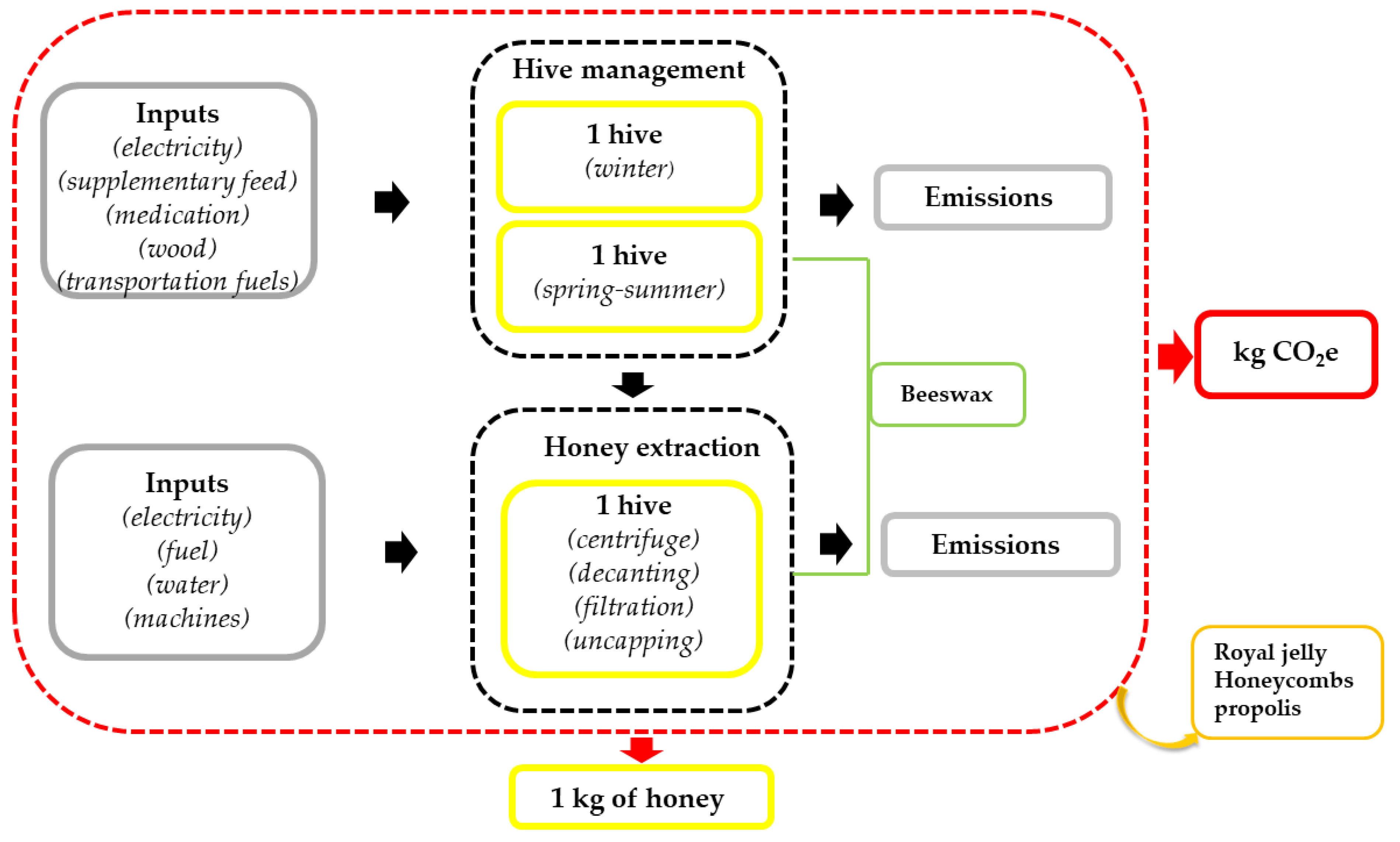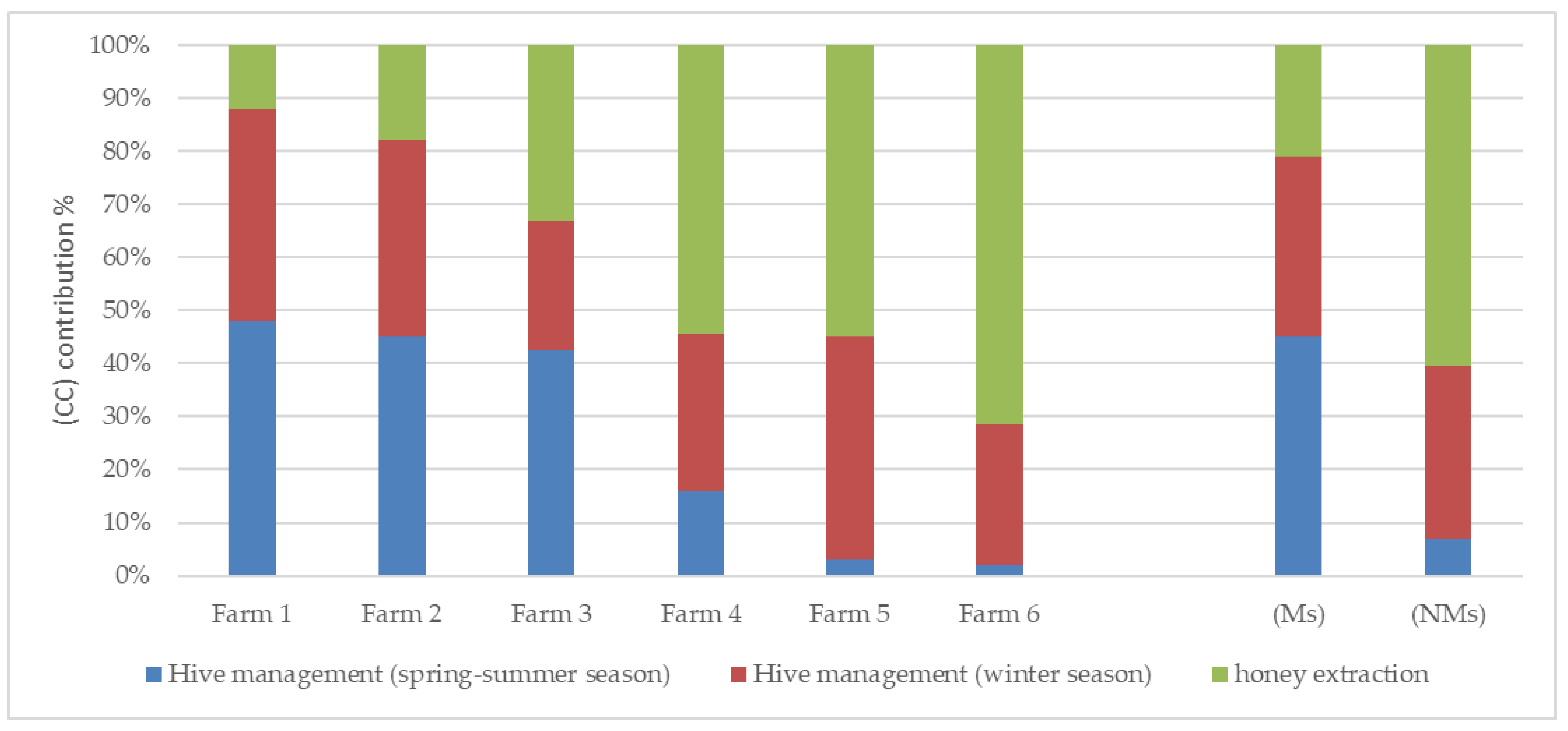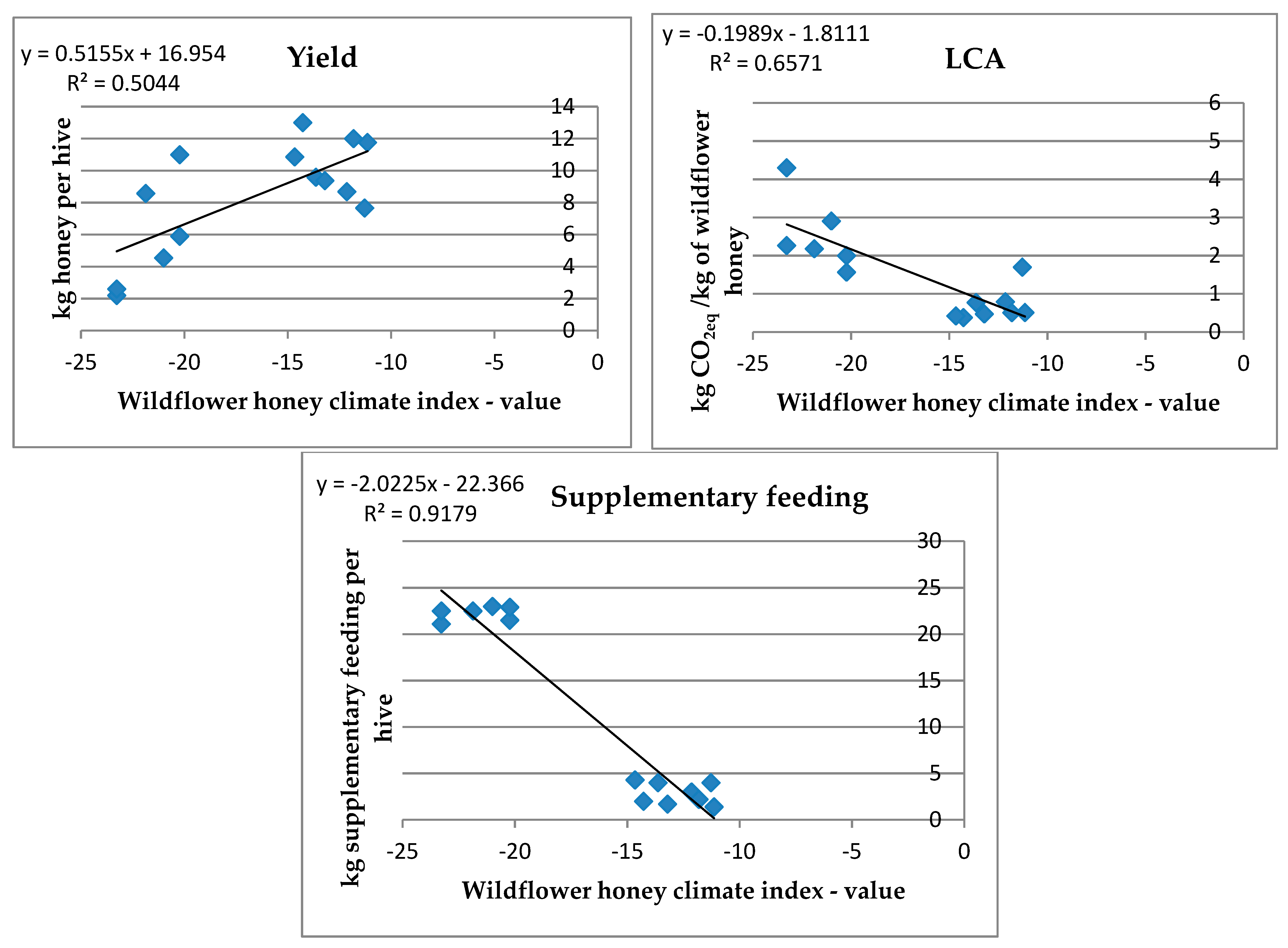Greenhouse Gas (GHG) Emissions from Honey Production: Two-Year Survey in Italian Beekeeping Farms
Abstract
Simple Summary
Abstract
1. Introduction
2. Materials and Methods
2.1. The Beekeeping Farms
2.2. Life Cycle Assessment (LCA)
2.2.1. Goal and Scope Definition
2.2.2. System Boundaries and ‘Functional Unit’
2.2.3. Life Cycle Inventory (LCI)
2.2.4. Allocation
2.2.5. Life Cycle Impact Assessment (LCIA)
2.3. Statistical Analysis
2.4. Development of a Prediction Index Based on Meteorological Data and Correlation between Environmental Impact and Honey Production
3. Results
3.1. Life Cycle Assessment Results
3.2. Development of a Prediction Index and Correlation between Environmental Impact
4. Discussion
4.1. GHG Emissions from Honey Production
4.2. Climate Influence on Honey Yield and GHG Emissions
5. Conclusions
Supplementary Materials
Author Contributions
Funding
Institutional Review Board Statement
Informed Consent Statement
Data Availability Statement
Acknowledgments
Conflicts of Interest
References
- Klein, A.M.; Vaissiere, B.E.; Cane, J.H.; Steffan-Dewenter, I.; Cunningham, S.A.; Kremen, C.; Tscharntke, T. Importance of pollinators in changing landscapes for world crops. Proc. R. Soc. B. 2007, 274, 303–313. [Google Scholar] [CrossRef]
- Silman, J.; Uusitalo, V.; Tapanen, T.; Salonen, A.; Soukka, R.; Kahiluoto, H. Contribution of honeybees towards the net environmental benefits of food. Sci. Total Environ. 2021, 756, 143880. [Google Scholar] [CrossRef]
- Rader, R.; Bartomeus, I.; Tylianakis, J.M.; Lalibertè, E. The winners and losers of land use intensification: Pollinator community disassembly is non-random and alters functional diversity. Divers. Distrib. 2014, 20, 908–917. [Google Scholar] [CrossRef]
- Gallai, N.; Salles, J.M.; Settele, J.; Vaissière, B.E. Economic valuation of the vulnerability of world agriculture confronted with pollinator decline. Ecol. Econ. 2009, 68, 810–821. [Google Scholar] [CrossRef]
- Leonhardt, S.D.; Gallai, N.; Garibaldi, L.A.; Kuhlmann, M.; Klein, A.M. Economic gain, stability of pollination and bee diversity decrease from southern to northern Europe. Basic. Appl. Ecol. 2013, 14, 461–471. [Google Scholar] [CrossRef]
- Lautenbach, S.; Seppelt, R.; Liebscher, J.; Dormann, C.F. Spatial and temporal trends of global pollination benefit. PLoS ONE 2012, 7, e35954. [Google Scholar] [CrossRef]
- Arzoumanidis, I.; Petti, L.; Raggi, A. Life Cycle Assessment of Honey: Considering the Pollination Service. Adm. Sci. 2019, 9, 27. [Google Scholar] [CrossRef]
- Pasupuleti, V.R.; Sammugam, L.; Ramesh, N.; Gan, S.H. Honey, propolis, and royal jelly: A comprehensive review of their biological actions and health benefits. Oxid. Med. Cell. Longev. 2017, 2017, 1259510. [Google Scholar] [CrossRef]
- Potts, S.G.; Imperatriz-Fonseca, V.; Ngo, H.T. Safeguarding pollinators and their values to human well-being. Nature 2016, 540, 220–229. [Google Scholar] [CrossRef]
- Malisa, G.; Yanda, P. Impacts of climate variability and change on beekeeping productivity. BAHPA 2016, 64, 49–55. [Google Scholar]
- Vercelli, M.; Novelli, S.; Ferrazzi, P.; Lentini, G.; Ferracini, C. A qualitative analysis of beekeepers’ perceptions and farm management adaptations to the impact of climate change on honey bees. Insects 2021, 12, 228. [Google Scholar] [CrossRef] [PubMed]
- Osservatorio Nazionale Miele. Miele: Andamento Produttivo e di Mercato per la Stagione 2021. Osservatorio Nazionale Miele, 2021. Available online: https://www.informamiele.it/wp-content/uploads/2021/10/Report-2021-Prime-Valutazioni.pdf (accessed on 10 December 2022).
- Holmes, W. The influence of weather on annual yields of honey. J. Agric. Sci. 2002, 139, 95–102. [Google Scholar] [CrossRef]
- Clarke, D.; Robert, D. Predictive modelling of honey bee foraging activity using local weather conditions. Apidologie 2018, 49, 386–396. [Google Scholar] [CrossRef]
- Gounari, S.; Proutsos, N.; Goras, G. How does weather impact on beehive productivity in a Mediterranean island? Ital. J. Agrometeorol. 2002, 1, 65–81. [Google Scholar] [CrossRef]
- Campbell, T.; Dixon, K.W.; Dods, K.; Fearns, P.; Handcock, R. Machine Learning Regression Model for Predicting Honey Harvests. Agriculture 2020, 10, 118. [Google Scholar] [CrossRef]
- Kremen, C.; Williams, N.; Aizen, M. Pollination and other ecosystem services produced by mobile organisms: A conceptual framework for the effects of land-use change. Ecol. Lett. 2007, 10, 299–314. [Google Scholar] [CrossRef]
- Cebotari, V.; Buzu, I.; Postolachi, O. Impact of climate change of air temperature on vital activity of the bee families. Sci. Pap. Ser. D. Anim. Sci. 2019, 62, 249–255. [Google Scholar]
- Giannini, T.C.; Costa, W.F.; Borges, R.C.; Miranda, L.; da Costa, C.P.W.; Saraiva, A.M.; Imperatriz Fonseca, V.L. Climate change in the Eastern Amazon: Crop-pollinator and occurrence-restricted bees are potentially more affected. Reg. Environ. Chang. 2020, 20, 1–12. [Google Scholar] [CrossRef]
- Gajardo-Rojas, M.; Muñoz, A.A.M.; Barichivich, J.; Klock-Barría, K.; Gayo, E.M.; Fontúrbel, F.E.; Veas, C. Declining honey production and beekeeper adaptation to climate change in Chile. Prog. Phys. Geogr. 2022, 46, 737–756. [Google Scholar] [CrossRef]
- Langowska, A.; Zawilak, M.; Sparks, T.H.; Glazaczow, A.; Tomkins, P.W.; Tryjanowski, P. Long-term effect of temperature on honey yield and honeybee phenology. Int. J. Biometeorol. 2017, 61, 1125–1132. [Google Scholar] [CrossRef]
- Solovev, V.V. Influence of weather conditions on the honey productivity of bee colonies in the Valdai district of the Novgorod region. IOP Conf. Ser. Earth Environ. Sci. 2020, 613, 01214. [Google Scholar] [CrossRef]
- Crenna, E.; Jolliet, O.; Collina, E.; Sala, S.; Fantked, P. Characterizing honey bee exposure and effects from pesticides for chemical prioritization and life cycle assessment. Environ. Int. 2020, 138, 105642. [Google Scholar] [CrossRef] [PubMed]
- Brosi, B.J.; Delaplane, K.S.; Boots, M.; De Roode, J.C. Ecological and evolutionary approaches to managing honeybee disease. Nat. Ecol. Evol. 2017, 1, 1250–1262. [Google Scholar] [CrossRef]
- VanEngelsdorp, D.; Meixner, M.D. A historical review of managed honey bee populations in Europe and the United States and the factors that may affect them. J. Invertebr. Pathol. 2010, 103, S80–S95. [Google Scholar] [CrossRef]
- Simone-Finstrom, M.; Li-Byarlay, H.; Huang, M.H.; Strand, M.K.; Rueppel, O.; Tarpy, D.R. Migratory management and environmental conditions affect lifespan and oxidative stress in honey bees. Sci. Rep. 2016, 6, 32023. [Google Scholar] [CrossRef] [PubMed]
- Pocol, C.B.; Šedík, P.; Brumă, I.S.; Amuza, A.; Chirsanova, A. Organic Beekeeping Practices in Romania: Status and Perspectives towards a Sustainable Development. Agriculture 2021, 11, 281. [Google Scholar] [CrossRef]
- Kendall, A.; Yuan, J.; Brodt, S.B. Carbon footprint and air emissions inventories for US honey production: Case studies. Int. J. Life Cycle Assess. 2013, 18, 392–400. [Google Scholar] [CrossRef]
- Mujica, M.; Blanco, G.; Santalla, E. Carbon footprint of honey produced in Argentina. J. Clean. Prod. 2016, 116, 50–60. [Google Scholar] [CrossRef]
- Vásquez-Ibarra, L.; Iriarte, A.; Villalobos, P.; Rengel, F.M.; Rebolledo-Leiva, R.; Angulo-Meza, L.; González-Araya, M.C. A wide environmental analysis of beekeeping systems through life cycle assessment: Key contributing activities and influence of operation scale. Int. J. Environ. 2022, 20, 790–805. [Google Scholar] [CrossRef]
- Arzoumanidis, I.; Petti, L.; Raucci, D.; Raggi, A. Multifunctional modelling in the life cycle assessment of honey considering pollination. Int. J. Life Cycle Assess. 2021, 26, 643–655. [Google Scholar] [CrossRef]
- Crenna, E.; Sala, S.; Polce, C.; Collina, E. Pollinators in life cycle assessment: Towards a framework for impact assessment. J. Clean. Prod. 2017, 140, 525–536. [Google Scholar] [CrossRef]
- Ulmer, M.; Smetana, S.; Heinz, V. Utilizing honeybee drone brood as a protein source for food products: Life cycle assessment of apiculture in Germany. Resour. Conserv. Recycl. 2020, 154, 104576. [Google Scholar] [CrossRef]
- Flores, J.M.; Gil-Lebrero, S.; Gámiz, V.; Rodríguez, M.I.; Ortiz, M.A.; Quiles, F.J. Effect of the climate change on honey bee colonies in a temperate Mediterranean zone assessed through remote hive weight monitoring system in conjunction with exhaustive colonies assessment. Sci. Total. Environ. 2019, 653, 1111–1119. [Google Scholar] [CrossRef] [PubMed]
- Aivazidou, E.; Iakovou, E.; Vlachos, D.; Keramydas, C. A methodological framework for supply chain carbon footprint management. Chem. Eng. 2013, 35, 313–318. [Google Scholar] [CrossRef]
- Clark, D. What’s a Carbon Footprint and How Is It Worked Out? 2012. Available online: https://www.theguardian.com/environment/2012/apr/04/carbon-footprint-calculated (accessed on 10 January 2023).
- García, C.A.; García-Trevino, E.S.; Aguilar-Rivera, N.; Aguilar-Rivera, C. Carbon footprint of sugar production in Mexico. J. Clean. Prod. 2016, 112, 2632–2641. [Google Scholar] [CrossRef]
- Demafelis, R.B.; Mendoza, C.T.; Matanguihan, A.E.D.; Malabuyoc, J.L.S.; Magadia Jr, R.V.; Pector, A.A.; Hourani, K.A.; Manaig, L.M.A.; Movillon, J.L. Carbon Footprint of Raw Sugar Production: Is Raw Sugar Carbon Positive or Negative? In Proceedings of the 62nd Philsutech Convention, Cebu City, Philippines, 13 August 2015. [Google Scholar]
- Pignagnoli, A.; Pignedoli, S.; Carpana, E.; Costa, C.; Dal Prà, A. Carbon Footprint of Honey in Different Beekeeping Systems. Sustainability 2021, 13, 11063. [Google Scholar] [CrossRef]
- ISO 14040; Environmental Management: Life Cycle Assessment, Principles and Framework. ISO International Standard Organization, 2010. Available online: https://www.iso.org/standard/37456.html (accessed on 10 January 2023).
- ISO 14040:2006; Environmental Management—Life Cycle Assessment—Principles and Framework, 2nd ed. ISO International Organisation for Standardisation: Geneva, Switzerland, 2006. Available online: https://www.iso.org/standard/37456.html (accessed on 10 January 2023).
- Pinna, M. Contributo alla classificazione del clima d’Italia, 2nd ed.; Rivista Geografica Italiana: Roma, Italy, 1970; Volume 77, pp. 129–152. Available online: https://dialnet.unirioja.es/servlet/articulo?codigo=6007302 (accessed on 10 January 2023).
- Koch, P.; Salou, T. AGRIBALYSE: Methodology, Version 1.1; ADEME: Angers, France, 2014; p. 384. [Google Scholar]
- Colomb, V.; Amar, S.A.; Mens, C.B. AGRIBALYSE, the French LCI database for agricultural products: High quality data for producers and environmental labelling. OCL-Oilseeds Fats Crop Lipids 2015, 22, D104. [Google Scholar] [CrossRef]
- Tillman, A.M. Significance of decision-making for LCA methodology. Environ. Impact. Assess. Rev. 2000, 20, 113–123. [Google Scholar] [CrossRef]
- Stocker, T.F.; Qin, D.; Plattner, G.K.; Tignor, M.; Allen, S.K.; Boschung, J.; Nauels, A.; Xia, Y.; Bex, V.; Midgley, P.M. (Eds.) IPCC, 2013: Climate Change 2013: The Physical Science Basis. Contribution of Working Group I to the Fifth Assessment Report of the Intergovernmental Panel on Climate Change; Cambridge University Press: Cambridge, UK; New York, NY, USA, 2013; p. 1535. Available online: https://www.ipcc.ch/site/assets/uploads/2018/03/WG1AR5_SummaryVolume_FINAL.pdf (accessed on 10 January 2023).
- European Commission. International Reference Life Cycle Data System (ILCD) Handbook—Specific guide for Life Cycle Inventory Data Sets, 1st ed.; Publications Office of the European Union: Luxembourg, March 2010. Available online: https://publications.jrc.ec.europa.eu/repository/handle/JRC48182 (accessed on 10 January 2023).
- Agenzia Prevenzione Ambiente Energia Emilia-Romagna (ARPAE-R), Meteorological Data. Available online: https://simc.arpae.it/dext3r/ (accessed on 30 August 2022).
- Regione Toscana, Servizio Idrologico e Geologico Regionale, Meteorological Data. Available online: https://cfr.toscana.it/index.php?IDS=42&IDSS=277 (accessed on 30 August 2022).
- Agenzia Regionale per la Protezione dell’Ambiente Ligure (ARPAL), Meteorological Data. Available online: https://www.arpal.liguria.it/tematiche/meteo/dati-osservati.html (accessed on 30 August 2022).
- Moreira, M.T.; Cortés, A.; Lijó, L.; Noya, I.; Piñeiro, O.; Omil, B.; Barral, M.T. Environmental Implications of Honey Production in the Natural Parks of Northwestern Spain. In Proceedings of the 2nd International Conference Adapt to Clima, Heraklion, Greece, 24–25 June 2019; Available online: http://uest.ntua.gr/adapt2clima/proceedings/pdf/ADAPTtoCLIMATE2019_%20Moreira_etal.pdf (accessed on 10 January 2023).
- Gaga, V.A.; Esaulov, V.N. Innovative technologies and modern facilities in beekeeping. IOP Conf. Ser. Mater. Sci. Eng. 2016, 142, 012022. [Google Scholar] [CrossRef]
- Zacepins, A.; Kviesis, A.; Ahrendt, P.; Richter, U.; Tekin, S.; Durgun, M. Beekeeping in the future—Smart apiary management. In Proceedings of the 2016 17th International Carpathian Control Conference (ICCC), High Tatras, Slovakia, 29 May–1 June 2016; pp. 808–812. [Google Scholar]
- Zacepins, A.; Brusbardis, V.; Meitalovs, J.; Stalidzans, E. Challenges in the development of Precision Beekeeping. Biosyst. Eng. 2015, 130, 60–71. [Google Scholar] [CrossRef]
- Kołtowski, Z. Beekeeping value of recently cultivated winter rape-seed cultivars. J. Apicult. Sci. 2002, 46, 23–32. [Google Scholar]
- Gordo, O.; Sanz, J.J. Temporal trends in phenology of the honey bee Apis mellifera (L.) and the small white Pieris rapae (L.) in the Iberian peninsula (1952–2004). Ecol Entomol. 2006, 31, 261–268. [Google Scholar] [CrossRef]
- Lever, J.J.; van Nes, E.H.; Scheffer, M.; Bascompte, J. The sudden collapse of pollinator communities. Ecol. Lett. 2014, 17, 350–359. [Google Scholar] [CrossRef] [PubMed]
- Menzel, A.; Sparks, T.; Estrella, N.; Koch, E.; Aasa, A.; Ahas, R.; Alm-Kübler, K.; Bissolli, P.; Braslavska, O.; Briede, A.; et al. European phenological response to climate change matches the warming pattern. Glob. Chang. Biol. 2006, 12, 1969–1976. [Google Scholar] [CrossRef]
- Porrini, C.; Mutinelli, F.; Bortolotti, L.; Granato, A.; Laurenson, L.; Roberts, K. The Status of Honey Bee Health in Italy: Results from the Nationwide Bee Monitoring Network. PLoS ONE 2016, 11, e0155411. [Google Scholar] [CrossRef]



| Beekeeping Farms | Climate Classification | Supplemental Feeding 2020 | Supplemental Feeding 2021 | Beehives Transported 2020 | Beehives Transported 2021 |
|---|---|---|---|---|---|
| Farm 1 | Subcontinental temperate (Cfa) | High | High | 80% | 60% |
| Farm 2 | Oceanic (Cfb) | Medium | High | 16% | 8% |
| Farm 3 | Hot summer Mediterranean (Csa) | Low | Low | 34% | 47% |
| Farm 4 | Subcontinental temperate (Cfa) | Low | Medium | 0% | 0% |
| Farm 5 | Continental temperate (Cfa) | Low | Low | 0% | 0% |
| Farm 6 | Continental temperate (Cfa) | Low | Low | 0% | 0% |
| Beekeeping Farms | Coproducts 2020 | Honey Allocation 2020 | Coproducts 2021 | Honey Allocation 2021 |
|---|---|---|---|---|
| Farm 1 | Beeswax Honeycombs Propolis Royal jelly | 93% | Beeswax Honeycombs Propolis Royal jelly | 93% |
| Farm 2 | Beeswax Honeycombs | 99% | Beeswax Honeycomb | 87% |
| Farm 3 | Beeswax | 99% | Beeswax | 99% |
| Farm 4 | Beeswax | 100% | Beeswax | 100% |
| Farm 5 | Beeswax Honeycombs Royal jelly | 88% | Beeswax | 100% |
| Farm 6 | Beeswax | 97% | Beeswax | 96% |
| Farm | System | Year | Electricity | Supplemental Feeding | Transport | Honey Yield | (CC) Contribution | ||||||
|---|---|---|---|---|---|---|---|---|---|---|---|---|---|
| Honey | Farm | System | Year | ||||||||||
| % of Total Impact | % of Total Impact | % of Total Impact | Kg of Honey/ Hive | Kg CO2 e/ kg of Honey | Mean ± s.e | p-Value | Mean ± s.e | p-Value | Mean ± s.e | p-Value | |||
| 1 | Ms | 2020 | 24 | 16 | 56 | 11.45 | 2.18 | 3.18 ± 0.77 | 0.039 | 2.48 ± 0.36 | <0.001 | 1.13 ± 0.31 | 0.265 |
| 2021 | 11 | 38 | 48 | 2.47 | 4.19 | ||||||||
| 2 | 2020 | 31 | 22 | 43 | 9.81 | 1.79 | 2.34 ± 0.42 | ||||||
| 2021 | 18 | 59 | 20 | 2.58 | 2.90 | ||||||||
| 3 | 2020 | 49 | 2 | 43 | 6.73 | 1.57 | 1.91 ± 0.26 | ||||||
| 2021 | 50 | 9 | 37 | 5.60 | 2.26 | ||||||||
| 4 | NM | 2020 | 75 | 8 | 0 | 10.27 | 0.42 | 0.69 ± 0.20 | 0.58 ± 0.09 | 1.93 ± 0.59 | |||
| 2021 | 47 | 49 | 0 | 6.53 | 0.96 | ||||||||
| 5 | 2020 | 84 | 7 | 0 | 15.0 | 0.47 | 0.62 ± 0.11 | ||||||
| 2021 | 53 | 39 | 0 | 4.53 | 0.77 | ||||||||
| 6 | 2020 | 87 | 5 | 0 | 21.42 | 0.37 | 0.44 ± 0.05 | ||||||
| 2021 | 87 | 8 | 0 | 11.0 | 0.51 | ||||||||
Disclaimer/Publisher’s Note: The statements, opinions and data contained in all publications are solely those of the individual author(s) and contributor(s) and not of MDPI and/or the editor(s). MDPI and/or the editor(s) disclaim responsibility for any injury to people or property resulting from any ideas, methods, instructions or products referred to in the content. |
© 2023 by the authors. Licensee MDPI, Basel, Switzerland. This article is an open access article distributed under the terms and conditions of the Creative Commons Attribution (CC BY) license (https://creativecommons.org/licenses/by/4.0/).
Share and Cite
Pignagnoli, A.; Pignedoli, S.; Carpana, E.; Costa, C.; Dal Prà, A. Greenhouse Gas (GHG) Emissions from Honey Production: Two-Year Survey in Italian Beekeeping Farms. Animals 2023, 13, 766. https://doi.org/10.3390/ani13040766
Pignagnoli A, Pignedoli S, Carpana E, Costa C, Dal Prà A. Greenhouse Gas (GHG) Emissions from Honey Production: Two-Year Survey in Italian Beekeeping Farms. Animals. 2023; 13(4):766. https://doi.org/10.3390/ani13040766
Chicago/Turabian StylePignagnoli, Arianna, Stefano Pignedoli, Emanuele Carpana, Cecilia Costa, and Aldo Dal Prà. 2023. "Greenhouse Gas (GHG) Emissions from Honey Production: Two-Year Survey in Italian Beekeeping Farms" Animals 13, no. 4: 766. https://doi.org/10.3390/ani13040766
APA StylePignagnoli, A., Pignedoli, S., Carpana, E., Costa, C., & Dal Prà, A. (2023). Greenhouse Gas (GHG) Emissions from Honey Production: Two-Year Survey in Italian Beekeeping Farms. Animals, 13(4), 766. https://doi.org/10.3390/ani13040766






